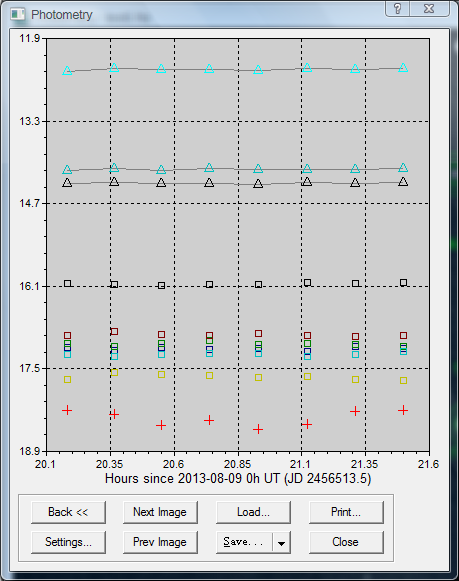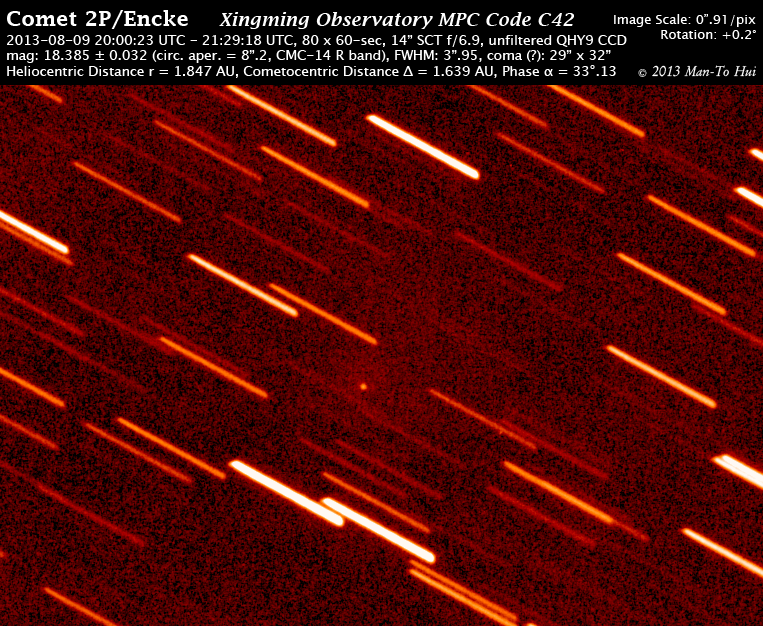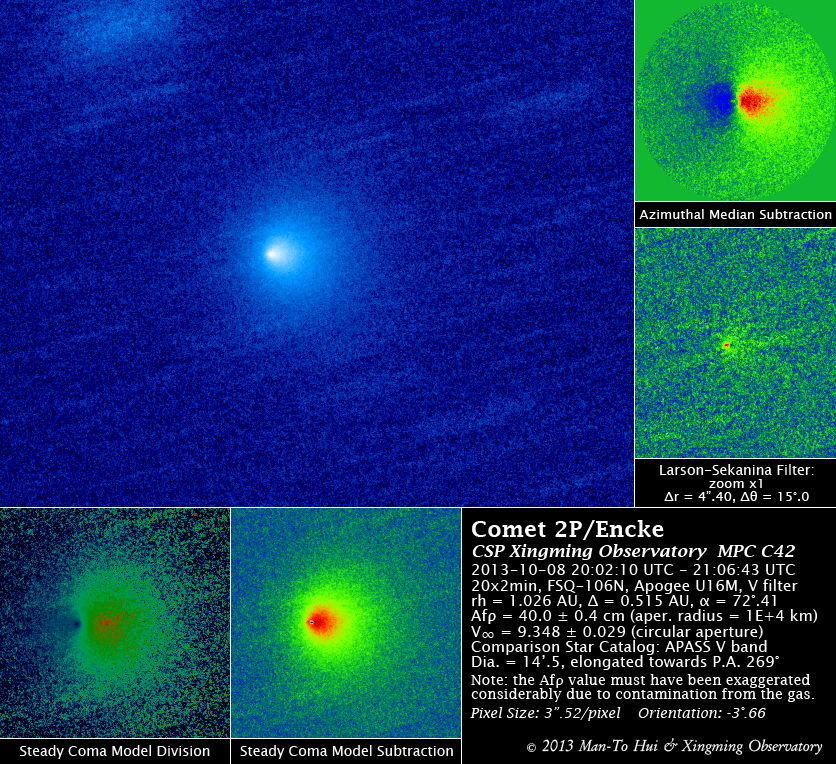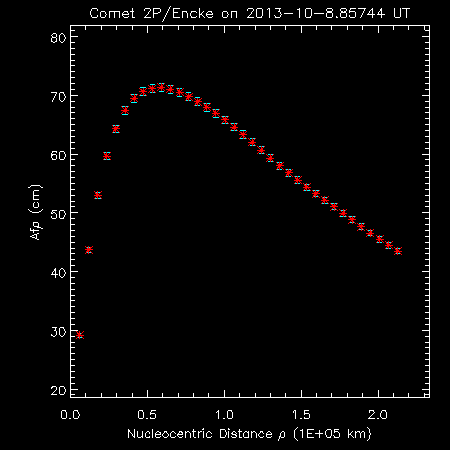Comet
2P/Encke
2013/08/09
2013/10/08
2013 Aug
09
|
Mouseover to
browse the image in BGRY color sequels version.
Both images are asinh stretched.
I noticed a
diffuse "halo" around the bright stellar nucleus, probably its
coma? However I could not find any evidence from obserations
from other observers. In order to rule out the possibility of it
being the effect from the imperfect flatfield image, I generated
a minimum image from all of the image sequence with background
centered around the nucleus normalized, with which the image
sequence was subtracted. The resulting individual images were
stacked both in average and median method, and the "halo" was
found in both, albeit the SNR in the median combined image
appeared poorer. Nevertheless, when I performed photometry in
IDL, I regarded the comet as a bare nucleus. The photometric
aperture was merely 2x its FWHM, which was ~1" greater than
surrounding sidereal stars of similar magnitude.
|
MPC observation computed with Astrometrica
using both UCAC-4 and CMC-14 star catalogs -- the former for astrometric
reduction and the latter for photometric work:
COD
C42
OBS M.-T. Hui, X. Gao
MEA M.-T. Hui
TEL 0.36-m f/6.9 Schmidt-Cassegrain + CCD
NET UCAC-4
COM Possible diffuse faint coma detected around the bright stellar
nucleus in,
COM the stacked image, size round 29" x 32".
0002P KC2013 08 09.83434 03 09
46.38 +27 26 11.7
18.0 N C42
0002P KC2013 08 09.83588 03 09
46.64 +27 26 13.0
18.2 N C42
0002P KC2013 08 09.83742 03 09
46.75 +27 26 13.8
18.2 N C42
0002P KC2013 08 09.83897 03 09
46.95 +27 26 15.9
18.4 N C42
0002P KC2013 08 09.84051 03 09
47.14 +27 26 16.9
18.2 N C42
0002P KC2013 08 09.84205 03 09
47.28 +27 26 17.9
C42
0002P KC2013 08 09.84360 03 09
47.48 +27 26 19.2
18.3 N C42
0002P KC2013 08 09.84514 03 09
47.65 +27 26 20.7
18.1 N C42
0002P KC2013 08 09.84668 03 09
47.80 +27 26 22.2
18.2 N C42
0002P KC2013 08 09.84823 03 09
48.09 +27 26 23.8
18.2 N C42
0002P KC2013 08 09.84977 03 09
48.13 +27 26 24.9
18.4 N C42
0002P KC2013 08 09.85132 03 09
48.32 +27 26 26.1
C42
0002P KC2013 08 09.85287 03 09
48.43 +27 26 26.8
18.4 N C42
0002P KC2013 08 09.85441 03 09
48.83 +27 26 28.6
18.3 N C42
0002P KC2013 08 09.85596 03 09
48.93 +27 26 30.0
18.3 N C42
0002P KC2013 08 09.85750 03 09
49.09 +27 26 31.0
18.2 N C42
0002P KC2013 08 09.85905 03 09
49.32 +27 26 32.9
18.2 N C42
0002P KC2013 08 09.86059 03 09
49.46 +27 26 34.0
18.2 N C42
0002P KC2013 08 09.86213 03 09
49.69 +27 26 35.5
18.1 N C42
0002P KC2013 08 09.86368 03 09
49.85 +27 26 36.8
18.3 N C42
0002P KC2013 08 09.86524 03 09
50.02 +27 26 38.2
18.3 N C42
0002P KC2013 08 09.86698 03 09
50.22 +27 26 39.0
18.1 N C42
0002P KC2013 08 09.86872 03 09
50.38 +27 26 40.3
18.1 N C42
0002P KC2013 08 09.87030 03 09
50.56 +27 26 42.1
18.4 N C42
0002P KC2013 08 09.87188 03 09
50.77 +27 26 43.9
18.4 N C42
0002P KC2013 08 09.87344 03 09
50.96 +27 26 44.6
18.3 N C42
0002P KC2013 08 09.87501 03 09
51.13 +27 26 46.4
18.4 N C42
0002P KC2013 08 09.87659 03 09
51.32 +27 26 47.5
18.5 N C42
0002P KC2013 08 09.87816 03 09
51.50 +27 26 49.1
18.4 N C42
0002P KC2013 08 09.87973 03 09
51.67 +27 26 50.4
18.2 N C42
0002P KC2013 08 09.88130 03 09
51.88 +27 26 51.6
18.2 N C42
0002P KC2013 08 09.88286 03 09
52.14 +27 26 53.5
18.2 N C42
0002P KC2013 08 09.88442 03 09
52.27 +27 26 54.5
18.2 N C42
0002P KC2013 08 09.88598 03 09
52.42 +27 26 56.1
18.2 N C42
0002P KC2013 08 09.88757 03 09
52.61 +27 26 57.2
18.2 N C42
0002P KC2013 08 09.88913 03 09
52.79 +27 26 58.8
18.1 N C42
0002P KC2013 08 09.89068 03 09
52.98 +27 26 59.7
18.2 N C42
0002P KC2013 08 09.89222 03 09
53.18 +27 27 01.0
18.4 N C42
0002P KC2013 08 09.89377 03 09
53.36 +27 27 02.4
18.3 N C42
0002P KC2013 08 09.89531 03 09
53.55 +27 27 03.6
18.5 N C42
Photometry result computed with FOCAS,
which processes images based upon the .LOG file of Astrometrica, by means of
Multibox method:
-
COD C42
OBS M.-T. Hui, X. Gao
CATALOG: USNO A2.0 / CMC-14 - BAND: R
10x10 20x20 30x30 40x40 50x50 60x60
SNR SB COD
COMET UTC
+/- +/- +/- +/-
+/- +/- N FWHM CAT
------------ ------------------- ----- -----
----- ----- ----- ----- ---- ----
---
2P
09/08/2013 20:46:35 18.26 17.83 17.53 17.28
17.09 16.97 7.8 20.2 C42
2P
09/08/2013 20:46:35* 0.11 0.15 0.25
0.33 0.41 0.49 38
4.0 CMC
AFRHO LOG
COMET UTC
DELTA r BOX " MAG
RSR CM +/- AFRHO OBS
------------ ------------------- ----- -----
----- ----- --- ----- ---- ----- ---
2P
09/08/2013 20:46:35 1.64 1.85 16.82
17.92 8 6
1 0.779 C42
FoCAs 3.42
www.astrosurf.com/cometas-obs
es.groups.yahoo.com/group/Cometas_Obs
Interpretation for FOCAS table
headings:
The upper section:
Fisrt line:
COMET, UTC: refering to their original meanings respectively
10x10, 20x20 ... 60x60: the aperture sizes
of photometry in term of rectangle in arcsec that are used to measure an
object's magnitude
SNR: the
Signal-to-Noise Ratio for aperture photometry
SB: stars of faintest magnitude on the images used in data
reduction with the used star catalog in Astrometrica, rather than the
stars of faintest magnitude in the images
COD:
MPC Code of the observatory
Second line:
+/-: precisions of measurement
N: the number of used images for
measurement
FWHM:
Full-Width-Half-Maximum of total PSF, relevant to degree of seeing
CAT: the used star catalog in AstrometricaThe lower section:DELTA
: cometocentric distance of the Earth
r: heliocentric distance of the comet
BOX: dimension of the box aperture, always equivalent to a spatial dimension of 2E+04 km enclosing the comet
MAG: magnitude of the comet enclosed by the box
RSR: SNR expressed in integer
AFRHO CM: Afrho value in centimeter
+/-: precision of Afrho
LOG AFRHO: equal to alog10(Afrho)
OBS: MPC code of the observatory
Please note that the FOCAS
also calculated Af$\rho $ for the comet. However, since the morphological
appearance of the comet greatly differentiated from the 1/$\rho$ coma model, I
would instead regard the value as meaningless.
As the observation lasted
over 1-hr, I attempted to utilize the data to see if there would be any
brightness change during the monitor. Unfortunately the tracking of the system
was extremely poor that even a 60-sec exposure would lead to trailed images. In
order to improve the SNR of the comet, I stacked every continuous 10 images
respectively according to the background stars as well as the motion of the
comet, which resulted in overall 8 datasets to be measured. (Frankly speaking I
had attempted to stack every 2 and 4 images, however, the SNR was still found
poor.) The images of untrailed stars were later fed into MaxImDL for
registration on stars and were stored. Subsequently I typed command lines to
crop the corresponding untrailed comet images centered on the optocenter,
substituted the upper left corner with the cropped comet images and saved them
in the working directory. As there was paper which proved the robustness and
reliability of photometry in MaxImDL, I applied the software for photometry for
saving time. Totally 6 comparison stars around the comet taken from NOMAD
catalog were used, along with neighboring three check stars, showed in the
following image. The photometric aperture radius was set to 8-pixel, with a gap
of 4-pixel and a sky annulus of 8-pixel.

The faint streak in the
image is trailed 2P/Encke. MaxImDL computed photometry as follows:
 '+' label the comet,
squares label comparison stars whereas triangles label check stars.
'+' label the comet,
squares label comparison stars whereas triangles label check stars.
The graphic shows some
variation in the brightness of the comet. Unfortunately MaxImDL did not show
uncertainties so I had to perform extra computation in IDL. By taking counting
statistics of electrons and the uncertainties from the zeropoints of each
dataset I obtained the following graphic.
Yet as the number of the
data was insufficient, I could not draw any conclusion about the lightcurve. It
is likely that the change in brightness was seen. Weather permitting I will keep
monitoring this comet.
Copyright @ Man-To
Hui
2013/08/25
2013 Oct
08
MPC observation computed with Astrometrica
using NOMAD star catalogs:
COD
C42
OBS X.Gao, M.-T. Hui
MEA M.-T. Hui
TEL 0.11-m f/5.0 refractor + CCD
NET NOMAD
0002P KC2013 10 08.83965 08 25
11.46 +42 14 43.8
14.4 N C42
0002P KC2013 10 08.85146 08 25
20.76 +42 14 21.6
14.5 N C42
0002P KC2013 10 08.86339 08 25
30.34 +42 13 58.1
14.5 N C42
0002P KC2013 10 08.87531 08 25
39.99 +42 13 38.6
14.2 N C42
Photometric measurements were performed in
IDL. 15 stars whose V mag were taken from APASS catalog with color index similar
to the sun were used to solve the zeropoint of the stacked image.
ZP =
23.1793+-0.0304691
aper mag emag
4.5 13.663+-0.033
9.0 12.469+-0.032
13.5 11.820+-0.031
18.0 11.379+-0.031
22.5 11.055+-0.031
27.0 10.805+-0.031
31.5 10.606+-0.031
36.0 10.443+-0.031
40.5 10.307+-0.031
45.0 10.190+-0.031
49.5 10.091+-0.031
54.0 10.005+-0.031
58.5 9.929+-0.031
63.0 9.863+-0.031
67.5 9.803+-0.031
72.0 9.749+-0.031
76.5 9.701+-0.031
81.0 9.660+-0.031
85.5 9.623+-0.031
90.0 9.590+-0.031
94.5 9.561+-0.031
99.0 9.535+-0.031
103.5 9.510+-0.031
108.0 9.487+-0.031
112.5 9.467+-0.031
117.0 9.448+-0.031
121.5 9.429+-0.031
126.0 9.412+-0.031
130.5 9.397+-0.031
135.0 9.384+-0.031
139.5 9.374+-0.031
144.0 9.365+-0.031
148.5 9.357+-0.031
153.0 9.350+-0.031
157.5 9.343+-0.031
162.0 9.337+-0.031
The aperture sizes are all in pixel.
Afrho data were derived as
well:
However, I must warn that there must be
contamination from gas emission due to the inappropriate bandpass used.
Copyright @ Man-To
Hui
2013/11/12
Feel free to e-mail
me with any doubts or questions.
Top
Back...
-- Zurück...
Home



